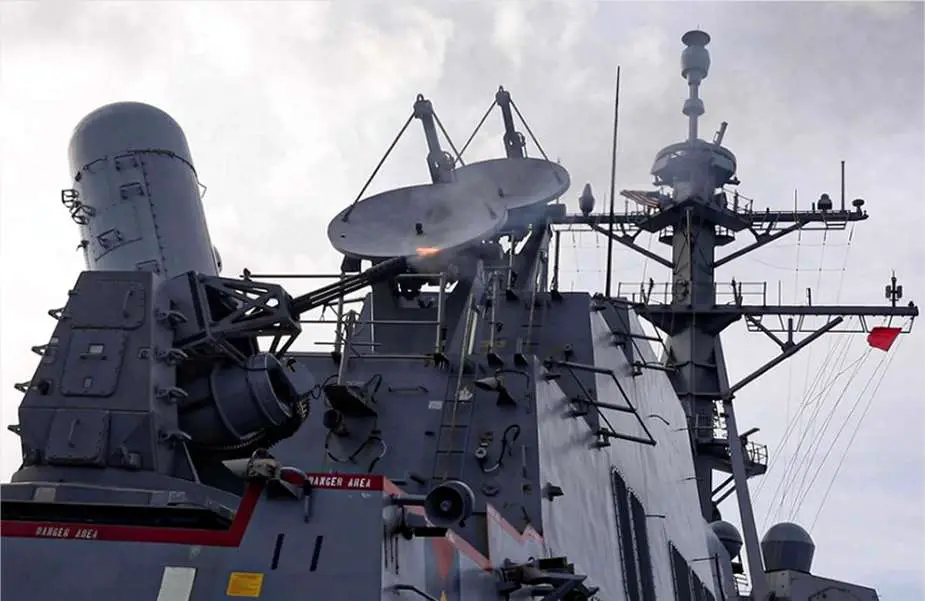On November 22, 2023, as part of a live-fire exercise showcasing its defensive capabilities, the Arleigh Burke-class destroyer USS Dewey (DDG 105) utilized its Phalanx Close-In Weapons System (CIWS). The exercise took place in the Philippine Sea, where the USS Dewey operates as part of Task Force 71/Destroyer Squadron (DESRON) 15, the Navy’s largest DESRON and the principal surface force of the US Navy's 7th Fleet.
Follow Navy Recognition on Google News at this link
 The Phalanx CIWS features a radar-guided 20 mm (0.8 in) M61 Vulcan cannon with a firing rate of 4,500 rounds per minute and an effective range of 1 to 5 nautical miles. (Picture source: US DoD)
The Phalanx CIWS features a radar-guided 20 mm (0.8 in) M61 Vulcan cannon with a firing rate of 4,500 rounds per minute and an effective range of 1 to 5 nautical miles. (Picture source: US DoD)
The Phalanx CIWS, a widely used automated defense system, was developed by General Dynamics, now part of Raytheon. Designed to provide close-in protection against various threats, including aircraft, missiles, and small boats, the Phalanx CIWS has been operational since 1980 and has been employed by numerous naval forces worldwide, including the United States, the United Kingdom, Australia, Canada, and New Zealand.
The Phalanx CIWS features a radar-guided 20 mm (0.8 in) M61 Vulcan cannon mounted on a swiveling base, connected to a Ku-band radar system. This six-barrel Gatling rotary cannon has a rapid firing rate of 4,500 rounds per minute, allowing an effective range of 1 to 5 nautical miles. Recognized for its automated operation and distinctive barrel-shaped radome, the Phalanx CIWS is commonly referred to as "R2-D2," drawing parallels to the droid from Star Wars films.
Operating autonomously with an automated fire-control system and human oversight, the Phalanx CIWS has undergone several upgrades since the 1980s. The latest standard, the Block 1B variant introduced in 2015, includes enhancements such as an automatic acquisition video tracker, optimized gun barrels, Enhanced Lethality Cartridges, and the Baseline 2 radar upgrade. These improvements aim to bolster the system's performance against diverse threats, including small maneuvering surface craft and low-flying aircraft.
The USS Dewey, commissioned into the United States Navy on March 6, 2010, is an Arleigh Burke-class destroyer named after Admiral George Dewey. With a displacement of 9,200 tons, a length of 155 m, a beam of 20 m, and a draft of 9.4 m, the vessel is powered by four General Electric LM2500-30 gas turbines, enabling it to reach speeds exceeding 30 knots.
In terms of armament, the USS Dewey is well-equipped, featuring a 5-inch (127 mm) lightweight gun, a 20 mm Phalanx CIWS, two 25 mm Mk 38 machine gun systems, and four 0.50-inch (12.7 mm) caliber guns. Additionally, the destroyer is armed with missile systems, utilizing a 32-cell and a 64-cell Mk 41 vertical launching system (VLS) for deploying various missiles, including surface-to-air, anti-ballistic, and Tomahawk cruise missiles.
The USS Dewey also stands as the first Arleigh Burke-class destroyer to be equipped with the Optical Dazzling Interdictor (ODIN), a directed energy laser system employed by the US Navy to counter Unmanned Aircraft Systems (UAS) threats. Furthermore, the vessel enhances its reconnaissance and anti-submarine warfare capabilities with the ability to carry two MH-60R Seahawk helicopters.



